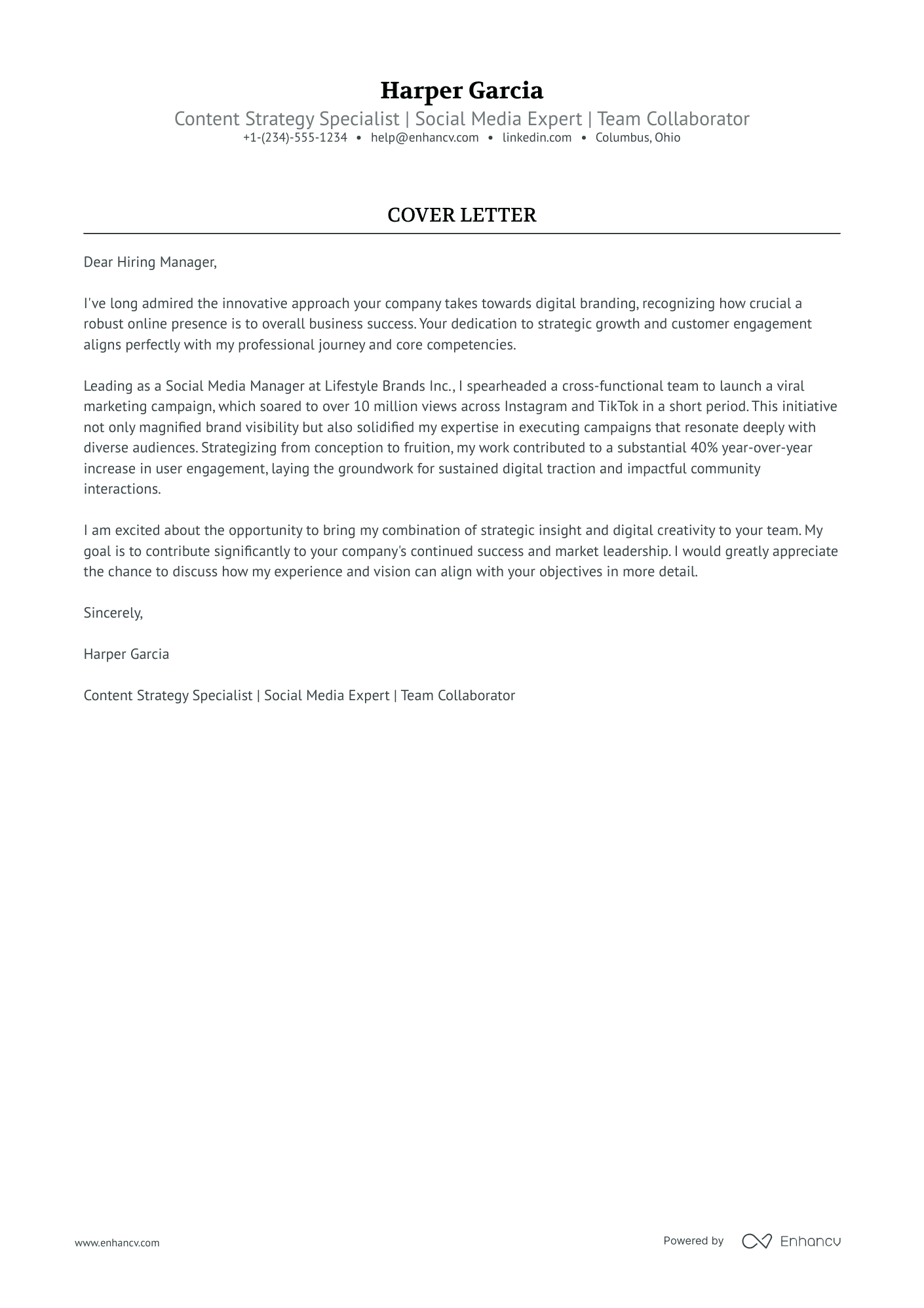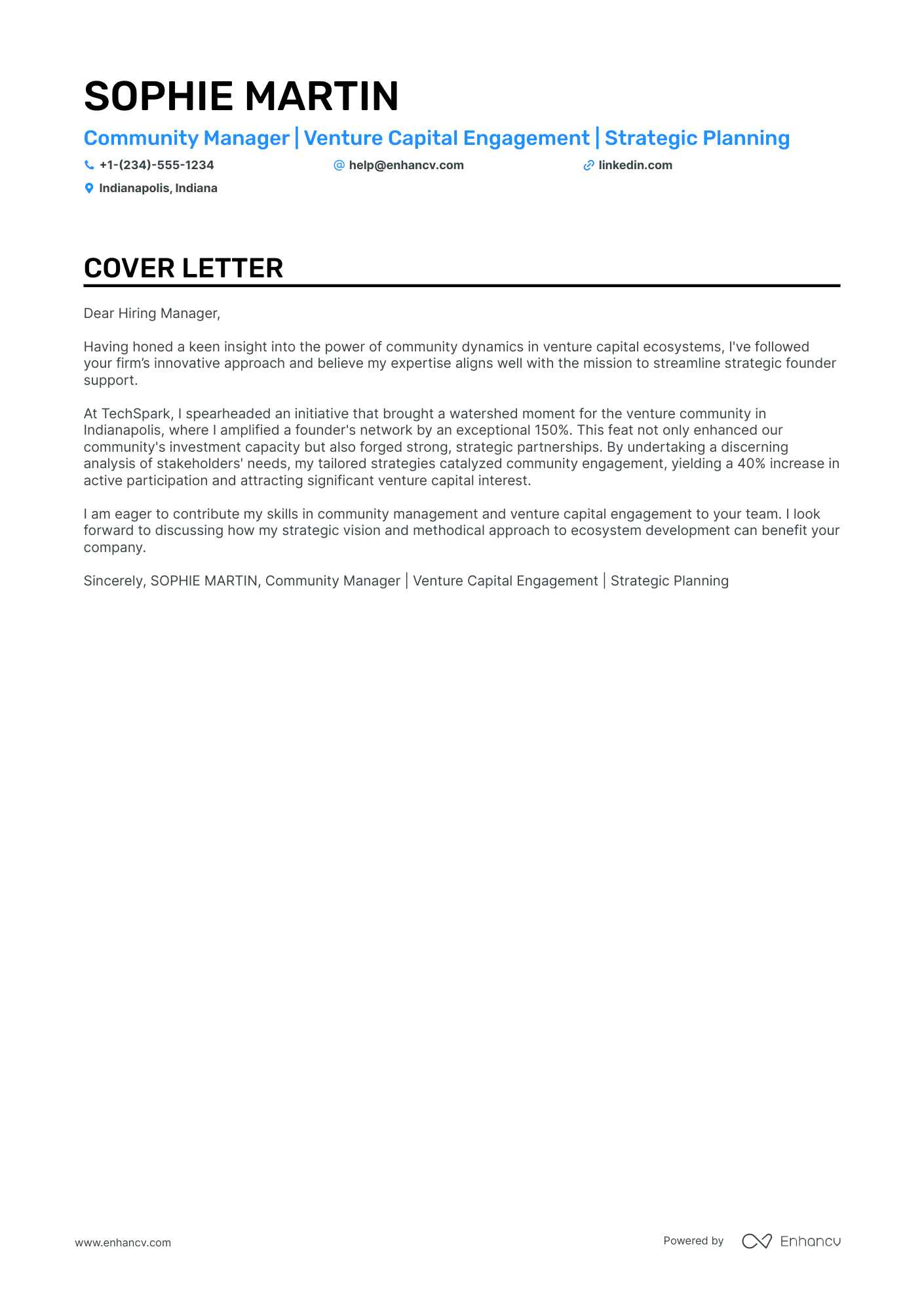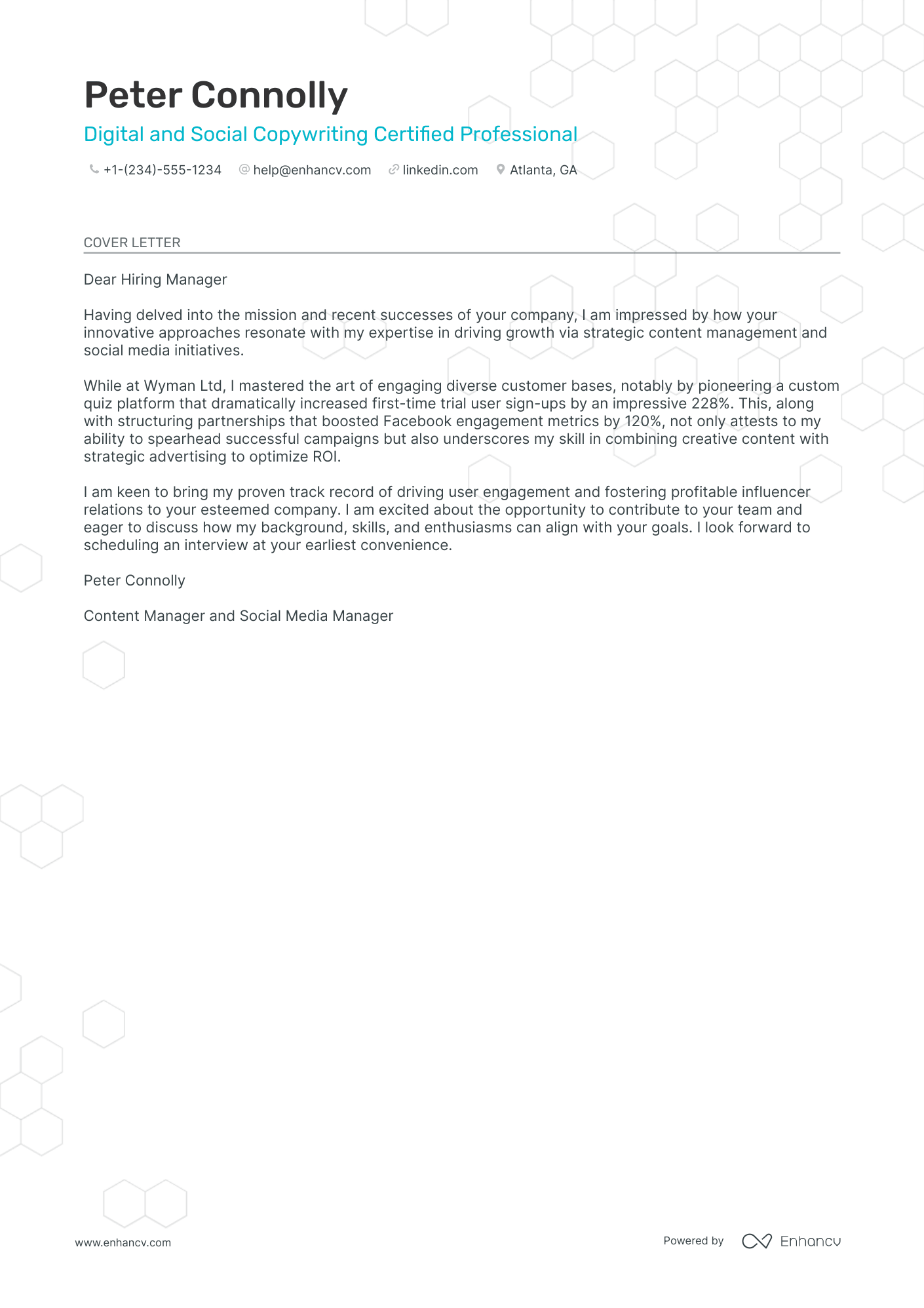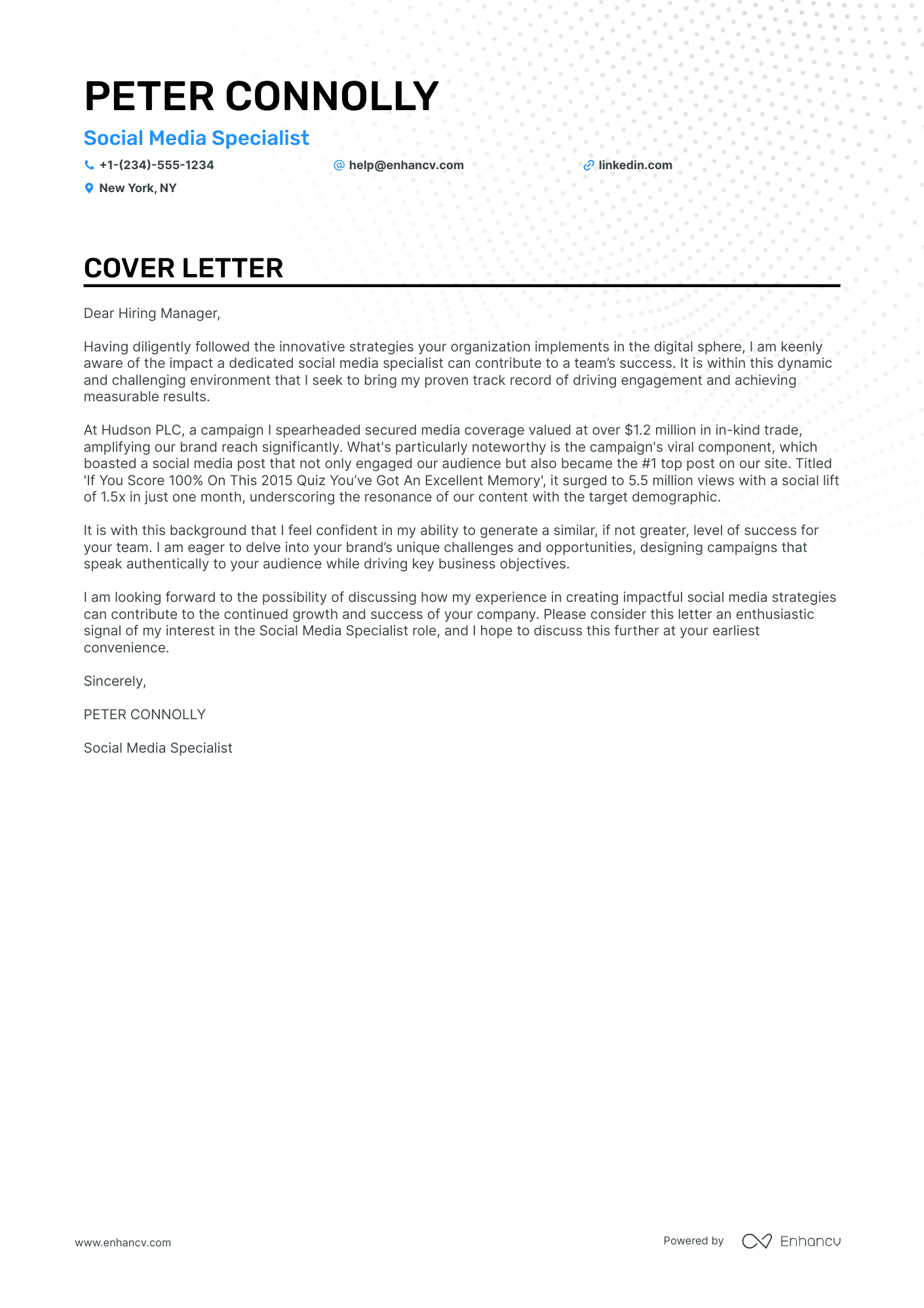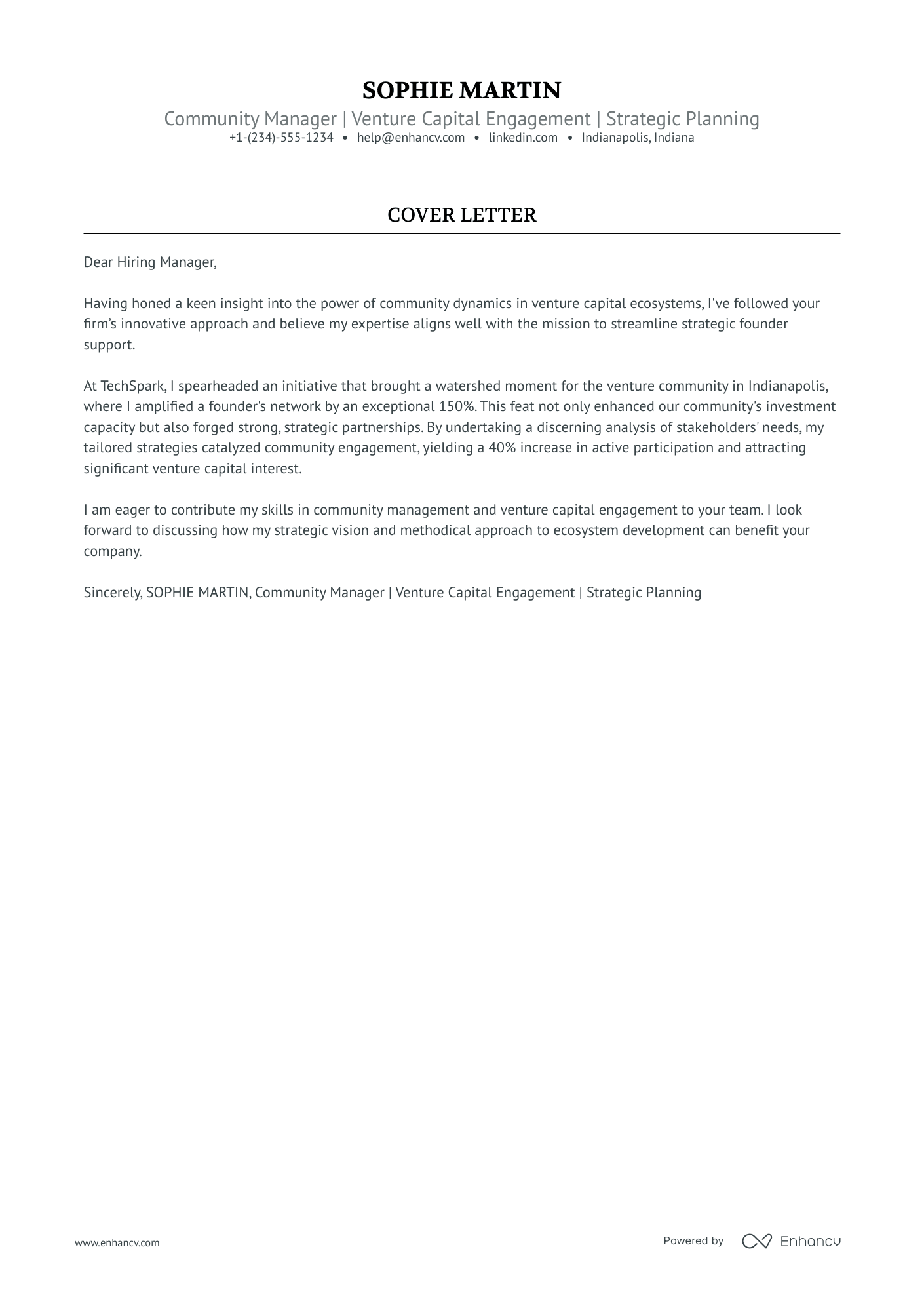Embarking on the journey to land your dream role as a social media manager, you've diligently crafted your resume only to realize a pivotal piece is missing: the cover letter. This isn't a space to regurgitate your resume; instead, seize this opportunity to share the narrative behind your proudest professional triumph. Striking the delicate balance between formality and genuine personality—minus the clichés—is key. Keep it concise, capped at one enlightening page, and you'll pen a cover letter that captivates.
- Writing the essential social media manager cover letter sections: balancing your professionalism and personality;
- Mixing storytelling, your unique skill set, and your greatest achievement;
- Providing relevant (and interesting) information with your social media manager cover letter, despite your lack of professional experience;
- Finding the perfect format for your[ social media manager cover letter, using templates from industry experts.
Leverage the power of Enhancv's AI: upload your resume and our platform will map out how your social media manager cover letter should look, in mere moments.
If the social media manager isn't exactly the one you're looking for we have a plethora of cover letter examples for jobs like this one:
- Social Media Manager resume guide and example
- Digital Marketing Specialist cover letter example
- Public Relations Specialist cover letter example
- Content Creator cover letter example
- Digital Marketing Executive cover letter example
- Marketing Manager cover letter example
- Assistant Brand Manager cover letter example
- Email Marketing cover letter example
- Regional Marketing Manager cover letter example
- Podcaster cover letter example
- Experiential Marketing cover letter example
Drop your resume here or choose a file.
PDF & DOCX only. Max 2MB file size.
Social media manager cover letter example
Peter Connolly
Atlanta, GA
+1-(234)-555-1234
help@enhancv.com
- Quantifying Success: The cover letter mentions specific achievements, such as the 228% increase in user sign-ups and a 120% boost in Facebook engagement metrics. These figures help to concretely demonstrate the candidate's ability to deliver results in the realm of content and social media management.
- Relevance to Company Goals: By discussing the alignment of personal expertise with the company's mission and recent successes, the candidate shows an understanding of the company's needs and how they can contribute to its objectives, making the application more targeted and effective.
- Concrete Examples of Expertise: The cover letter provides a clear example of a tool the candidate developed (a custom quiz platform) which allows the hiring manager to understand the nature of their skills and the impact of their work directly.
- Initiative and Innovation: The cover letter emphasizes the candidate's initiative in developing new partnerships and pioneering projects, suggesting not only the skill to execute tasks but also the creativity and forward-thinking necessary for a role that involves content creation and social media engagement.
What about your social media manager cover letter format: organizing and structuring your information
Here is one secret you should know about your social media manager cover letter assessment. The Applicant Tracker System (or ATS) won't analyze your cover letter.
You should thus focus on making an excellent impression on recruiters by writing consistent:
- Header
- Greeting
- Introduction
- Body paragraphs (and explanation)
- Promise or Call to action
- Signature (that's optional)
Now, let's talk about the design of your social media manager cover letter.
Ensure all of your paragraphs are single-spaced and have a one-inch margins on all sides (like in our cover letter templates).
Also, our cover letter builder automatically takes care of the format and comes along with some of the most popular (and modern) fonts like Volkhov, Chivo, and Bitter.
Speaking of fonts, professionals advise you to keep your social media manager cover letter and resume in the same typography and avoid the over-used Arial or Times New Roman.
When wondering whether you should submit your social media manager cover letter in Doc or PDF, select the second, as PDF keeps all of your information and design consistent.
Writing a cover letter is easy with our free cover letter generator. Make one in seconds from your resume.
The top sections on a social media manager cover letter
- Header: This section includes your contact information, the date, and the employer's contact information, crucial for a social media manager to demonstrate attention to detail and communication skills.
- Greeting: Personalize the greeting with the recruiter's name, showing your research skills and your commitment to building professional relationships, key in social media management.
- Introduction: Introduce yourself and briefly mention your social media experience to immediately capture the recruiter's attention and align your expertise with the job requirements.
- Body: Detail your achievements in growing an audience, crafting engaging content, and measuring analytics, since these are core responsibilities of a social media manager and highlight your competency for the role.
- Closing: End with a compelling call to action, such as expressing eagerness to discuss your strategies, reflecting the engagement tactics necessary for social media success.
Key qualities recruiters search for in a candidate’s cover letter
Expertise in Various Social Media Platforms: Recruiters look for candidates with a deep knowledge of different social media channels, as this is essential for tailoring content and campaigns to fit each platform's unique audience and features.
Content Creation and Curation Skills: A standout social media manager must have a proven ability to create engaging, high-quality content as well as curate relevant third-party content that resonates with the audience.
Data-Driven Analytical Abilities: Recruiters prioritize applicants who can analyze social media metrics to inform strategy, track performance, and pivot campaigns for better engagement and ROI.
Adaptive Communication and Writing Talent: The role requires exceptional writing skills tailored to the brand’s voice and the ability to adapt messaging to various audiences and social media channels.
Trend Awareness and Proactivity: Since social media trends evolve rapidly, recruiters value candidates who stay ahead of the curve and can quickly integrate new trends into their social media strategies.
Community Engagement and Customer Service Mindset: The ability to actively engage with the community, respond to comments and messages promptly, and maintain a positive brand image is key for a social media manager.
Kick off your social media manager cover letter: the salutation or greeting
When writing your social media manager cover letter, remember that you're not writing for some complex AI or robot, but for actual human beings.
And recruiters, while on the lookout to understand your experience, would enjoy seeing a cover letter that is tailored to the role and addresses them. Personally.
So, if you haven't done so, invest some time in finding out who's the hiring manager for the role you're applying to. A good place to start would be LinkedIn and the corporate website.
Alternatively, you could also get in touch with the company to find out more information about the role and the name of the recruiter.
If you haven't met the hiring manager, yet, your social media manager cover letter salutation should be on a last-name basis (e.g. "Dear Mr. Donaldson" or "Dear Ms. Estephan").
A good old, "Dear HR Professional" (or something along those lines) could work as your last resort if you're struggling to find out the recruiter's name.
List of salutations you can use
- Dear Hiring Manager,
- Dear [Company Name] Recruiting Team,
- Dear [Company Name] Team,
- Dear [Department Head's Title, e.g., Marketing Director],
- Dear [Full Name of the Recipient],
- Dear Mr./Ms. [Last Name],
First introductions in your social media manager cover letter
Within your social media manager cover letter introduction, genuinely state what you like about the organization.
Research the latest company projects, honorary awards, company updates, etc.
Write up to two sentences to let recruiters know what impresses you about the company,
This would help you to set a good tone for the rest of the communication.
How to write an achievement-focused social media manager cover letter body
We've got the intro and greeting covered. Now, comes the most definitive part of your social media manager cover letter - the body.
In the next three to six paragraphs, you'd have to answer why should recruiters hire you.
What better way to do this than by storytelling?
And, no, you don't need a "Once upon a time" or "I started from the bottom and made it to the top" career-climbing format to tell a compelling narrative.
Instead, select up to three most relevant skills for the job and look back on your resume.
Find an achievement, that you're proud of, which has taught you these three job-crucial skills.
Quantify your accomplishment, using metrics, and be succinct in the way you describe it.
The ultimate aim would be to show recruiters how this particular success has built up your experience to become an invaluable candidate.
Thinking about the closing paragraph of your social media manager cover letter
Before your signature, you have extra space to close off your social media manager cover letter.
Use it to either make a promise or look to the future.
Remind recruiters how invaluable of a candidate you are by showing what you plan to achieve in the role.
Also, note your availability for a potential next meeting (in person or over the telephone).
By showing recruiters that you're thinking about the future, you'd come off as both interested in the opportunity and responsible.
Which story should you tell in your social media manager cover letter when you have zero experience
Candidates, lacking professional experience in the field - this one is for you.
Your social media manager cover letter is an exercise of integrity, honesty, and, above all, spinning a positive narrative around your strengths.
And what better way to capture recruiters' attention than with your most job-relevant achievement (this could be from your internship or volunteering experience)?
Make sure to back up your success with transferrable skills that are relevant to the job (e.g. how your year, studying abroad, has taught you to be more motivated and handle multicultural environments).
Another safe card you can bet on is your career dream: in the body of your social media manager cover letter, go into the details of how your ambitions would help make the company you're applying for better.
Key takeaways
Turning your social media manager cover letter into a success is all about staying authentic to yourself and relevant to the job:
- Be creative with your social media manager cover letter introduction by stating something you enjoy about the company (that is genuine) or about your skill set (to get the recruiters' interested);
- Use single spacing and have a one-inch margin wrapping all around the content of your social media manager cover letter;
- Select just one past achievement from your career or life to tell a story of how you've obtained job-crucial skills and how they'd be beneficial to the role;
- The finishing paragraph of your social media manager cover letter doesn't necessarily have to be a signature but could be a promise of what you plan to achieve in the role;
- Instead of focusing on your lack of experience, spotlight your transferable skills, one relevant achievement, and career dreams.
Social Media Manager cover letter examples
By Experience
Social Media Intern
Entry-Level Social Media Manager
Senior Social Media Manager
By Role



